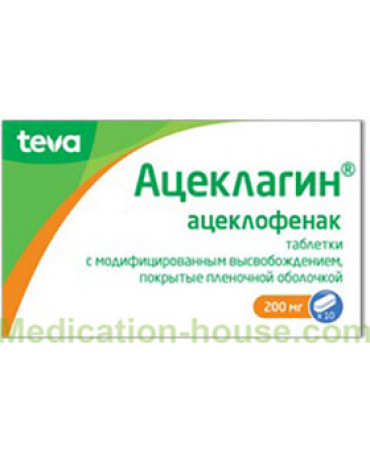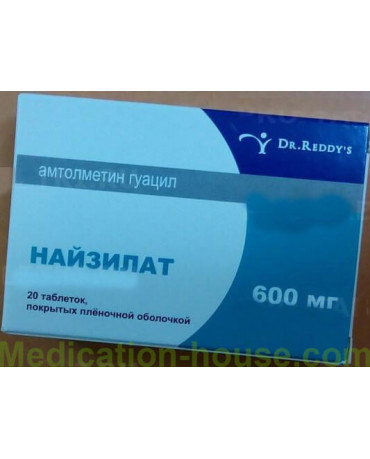User manual for Aceclofenac
To buy Aceclofenac just add it to your shopping cart
As with other NSAIDs, one of the mechanisms of action is the suppression of cyclooxygenase (COX), a key enzyme in the metabolism of arachidonic acid into prostaglandins (PG). There are two isoforms, TsOG1 and TsOG2, which are involved, respectively, in the production of physiological PG and proinflammatory.
COX1 is determined in the endothelium, gastric mucosa and kidneys, while COX2 is induced by pro-inflammatory cytokines and endotoxin in cells in vitro and in vivo inflammation.
A recent comparison of Aceclofenac with selective NSAIDs such as Celecoxib and Rofecoxib with respect to the inhibition of the activity of COX1 and COX2 in human whole blood showed that Aceclofenac inhibits both isoenzymes, but mainly the expression of COX2 and thus approaches the selective ones.
After oral administration, aceclofenac has a high degree of absorption. Cmax is reached within 1.25-3 hours. It penetrates into the synovial fluid, where its concentration reaches 57% of the plasma concentration level and the time to reach Cmax 2-4 hours later than in the plasma. Vd - 25 l.
Plasma protein binding (albumin) - 99%. Aceclofenac circulates mainly unchanged, its main metabolite is 4'-hydroxyaceclofenac. T1 / 2 is 4 hours.
Excreted by the kidneys, mainly in the form of hydroxy derivatives (about 2/3 of the administered dose).
Indications for use
What helps Aceclofenac from? Prescribe the drug in the following cases:
rheumatoid arthritis;
osteoarthritis;
ankylosing spondylitis (symptomatic therapy);
lumbago;
toothache;
humeroscapular periarthritis;
rheumatic lesions of soft tissues (for relief of inflammation and pain).
Instructions for use Aceclofenac, dosage
The drug should be taken in the minimum effective dose for as short a period as possible.
Aceclofenac tablets are swallowed, swallowed whole, washed down with a sufficient amount of liquid.
Standard dosage:
Adults are prescribed 1 tablet of Aceclofenac 100 mg 2 times a day, morning and evening.
Elderly patients do not need to change the daily dose of aceclofenac or the frequency of its use.
There is no evidence that a change in the daily dose of the drug is required when used in patients with renal insufficiency. But, as with other NSAIDs, caution is required.
The initial dose of Aceclofenac in patients with hepatic insufficiency is 100 mg per day. The duration of therapy without consulting a doctor should not exceed 7 days.
Side effects
Appointment of aceclofenac may be accompanied by the following side effects:
On the part of the skin and allergic reactions - skin rash, urticaria, eczema, pneumonitis, exacerbation of asthma, Stevens-Johnson syndrome, Lyell's syndrome, anaphylactic shock.
On the part of the nervous system - headache, dizziness, drowsiness, depression, irritability, tremor, convulsions, paresthesia, impaired vision and hearing, aseptic meningitis.
On the part of the cardiovascular system - arterial hypertension, heart failure, tachycardia, peripheral edema.
From the genitourinary system - hematuria, interstitial nephritis, acute renal failure, nephrotic syndrome.
Changes in laboratory tests - thrombocytopenia, leukopenia, anemia (including hemolytic and aplastic), agranulocytosis, proteinuria, increased levels of liver enzymes in the blood can be observed.
To reduce the severity of adverse reactions, you can reduce the effective dose needed to control pain symptoms.
Contraindications
It is contraindicated to appoint Aceclofenac in the following cases:
Patient's allergy to the active substance in the composition;
Severe asthma;
Respiratory diseases;
Bouts of rhinitis;
The appearance on the skin urticaria;
Bleeding in the stomach;
Open ulcers;
Problems with the work of the heart;
Bouts of angina pectoris;
If the patient has previously had a myocardial infarction;
Artery disease;
Bouts of ischemic attacks;
Problems with the work of the liver and kidneys.
Because of the likelihood of deterioration of renal excretion and the occurrence of edema, the drug should be taken with caution in renal, hepatic, heart failure, as well as in the presence of other diseases that predispose to the development of edema.
Also, patients with an increased risk of developing hypovolemia and taking diuretic drugs need careful administration of Aceclofenac.
Overdose
In medical practice, cases of overdose are not registered. But manufacturers in the instructions say that the symptoms can be headache and dizziness, bouts of vomiting and nausea, abdominal pain.
Gastric lavage and symptomatic therapy is recommended.
Diclofenac and Aceclofenac, which is better?
Both drugs are derivatives of phenylacetic acid. Unlike Diclofenac, Aceclofenac has fewer side effects, does not accumulate in the body, and more accurately affects the metabolism processes in cartilage. Research on therapeutic properties continues.
Terms of sell
To buy Aceclofenac the prescription is not required.




